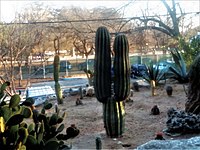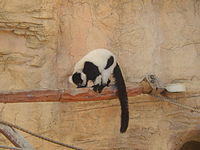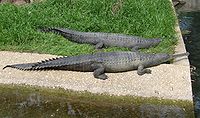San Antonio Zoo
| San Antonio Zoo | |
|---|---|
 San Antonio Zoo logo | |
 Zoo entrance | |
 | |
| 29°27′53″N 98°28′19″W / 29.4648°N 98.4719°W | |
| Date opened | May 3, 1914 |
| Location | 3903 N. St. Mary's Street San Antonio, Texas, United States |
| Land area | 57 acres (23 ha)[1] |
| No. of animals | 3,500+ |
| No. of species | 750 |
| Annual visitors | 1.1 million+[1] |
| Memberships | AZA,[2] ZAA[3] |
| Public transit access | Viva Trolley #11 |
| Website | sazoo |
The San Antonio Zoo is a 57-acre (23 ha) zoo located in Brackenridge Park in San Antonio, Texas, United States. It is home to over 750 species, some of which are endangered or extinct in the wild, and has an annual attendance of more than 1 million.[4][5] The zoo also hosts the Richard Friedrich Aquarium, which opened in 1948.[6] It was the only aquarium in the city until SeaWorld San Antonio opened in 1988.[citation needed] It also runs non-animal attractions, such as the San Antonio Zoo Train, which first opened in 1956.[7]
Description
The San Antonio Zoo spans 57 acres (23 ha) in Brackenridge Park, located in the city's Midtown area. It is accredited through the Association of Zoos and Aquariums (AZA)[2] and the Zoological Association of America (ZAA).[3]
Exhibits and other buildings


Monkey House and Commissary
Monkey House/Commissary (San Antonio Zoo) | |
| Coordinates | 29°27′45.9″N 98°28′24.5″W / 29.462750°N 98.473472°W |
|---|---|
| Built | 1937 |
| Architect | Adams & Adams |
| Architectural style | Spanish Revival |
| MPS | Historic Buildings and Structures of the San Antonio Zoo |
| NRHP reference No. | 100010141 |
| Added to NRHP | April 4, 2024 |
The Monkey House and Commissary at the San Antonio Zoo was built between 1935 and 1937. It was designed by San Antonio architecture firm Adams & Adams in the Spanish Revival style. Throughout the decades, it has variably served as an animal commissary, veterinary office, staff offices, and the zoo's monkey house. It was listed on the National Register of Historic Places (NRHP) on April 4, 2024, for its architectural value.[8] The building and surrounding plaza were renovated in 2023 ahead of the NRHP nomination, and the structure itself was converted into concessions and restrooms.[9]
San Antonio Zoo Train

The San Antonio Zoo Train, formerly the Brackenridge Eagle, is a 2 ft (610 mm) narrow gauge miniature train that connects the zoo to various points of interest within Brackenridge Park. The railway opened in 1956 and had 1 million passengers during its first two years of operation.[7]
History
Opening
What is now known as the San Antonio Zoo began in 1914 when George Washington Brackenridge, one of the city's leading citizens, placed several animals, including bison, deer, monkeys, African lions, and bears, on land he had deeded to the city. The land became Brackenridge Park and Golf Course.[4]
The San Antonio Zoo opened two of the first cageless exhibits in the United States in November 1929 that offered visitors views of the animals not available in caged exhibits. The Richard Friedrich Aquarium was dedicated in 1948, and the Hixon Bird House, funded through the efforts of Frederick C. Hixon, opened in 1966.[4]
The San Antonio Zoo housed the first herd of addra gazelle in captivity in 1969 and continues to be active in the breeding program for the critically endangered species. Due to the former hoofstock quarantine point in San Antonio, the San Antonio Zoo has historically had a wide variety of hoofstock species.
The Great (Little) Train Robbery
On July 18, 1970, two bandits held up the Brackenridge Eagle at gunpoint and robbed its passengers. Some passengers initially believed it was a stunt for a charity fundraiser. The robbers fled the scene with $500 ($3,923 in 2023), as well as car keys, checkbooks, and other valuables.[10] Ten days later, two soldiers from Fort Sam Houston, James R. Brown and Paul E. Smith, were apprehended for the crime. Both were discharged from the U.S. Army and later convicted; Smith was sentenced to 20 years and Brown to 10 years.[11][12] Dubbed "the Great (Little) Train Robbery", this holdup has remained the last train robbery in Texas.[12][13]
21st century
Phase I of Africa Live!, which opened in 2008, brought a new exhibit for hippos with underwater viewing area and one for new Nile crocodiles as well as many other smaller animals. Phase II contains Angolan colobus monkeys, okapi, African hunting dogs, rock hyrax, and various species of birds contained in the second largest aviary in the world. The zoo opened Phase II of Africa Live! in 2010.[4]
On June 18, 2013, a two-headed Texas river cooter turtle hatched. The turtle was named Thelma and Louise after the 1991 film.[14] Thelma and Louise died on July 29, 2014, from unknown causes.[15]
Josh the African lion was permanently transferred to the Birmingham Zoo in April 2022 as part of the AZA's Species Survival Plan.[16]
The zoo began construction of its new gorilla habitat, Congo Falls, in 2023. The zoo's previous gorilla habitat closed with the relocation of its last gorilla to the National Zoo in 1990.[17] The 2-acre (0.81 ha) exhibit is scheduled to open in late 2025.[18]
In October 2024, San Antonio Zoo opened its expanded African habitat, the Naylor Savanna, which greatly increased exhibit space for African species and included a new giraffe barn. Upon its opening, the new habitat was the largest in the zoo's history.[19][20] The Spekboom Lodge, situated in the middle of the giraffe habitat, opened as a space for guests to rent a night in the zoo on November 1, 2024.[21]
Conservation
The Center for Conservation and Research at the San Antonio Zoo is involved in breeding a number of endangered species including black rhino, leopard, golden lion tamarin, dama gazelle, Attwater's prairie chicken (housed and bred off-exhibit), black mangabey, African lion, black-footed ferret, Komodo dragon, Andean condor, and Caribbean flamingos.
The zoo is also involved in the conservation of the Texas horned lizard through its Texas Horned Lizard Reintroduction Project, breeding and then releasing the animals back into their native habitat.[22] The project runs in collaboration with several organizations, including the Texas Parks and Wildlife Department and Zoo Miami.[23] As of 2024, the center had released 258 individuals into the wild.[24]
Incidents
In 1992, a zookeeper, Jubal Cox, was tossed by an Asian elephant and received fatal injuries. The zoo launched an investigation into the circumstances surrounding the incident and decided not to euthanize the elephant. Cox's death was the first in the zoo's history.[25] This incident marked the end of elephant rides at the zoo.[4]
Species
The San Antonio Zoo is home to over 3,500 animals belonging to 750 species.[5]
Mammals

- Addax
- Addra gazelle
- African elephant (Coming Soon)
- African lion
- African pygmy goat
- African wild dog
- American black bear
- Angola colobus
- Asian elephant
- Bat-eared fox
- Black howler monkey
- Black-and-white ruffed lemur
- Black-footed cat
- Black-tailed prairie dog
- Blue duiker
- Bush dog
- Capybara
- Colombian white-faced capuchin
- Common squirrel monkey
- Common warthog
- Crested porcupine
- Fishing cat
- Fossa
- Francois' langur
- Geoffroy's marmoset
- Giant anteater
- Giraffe
- Golden lion tamarin
- Golden-headed lion tamarin
- Hippopotamus
- Jaguar
- Kinkajou
- Kirk's dik-dik
- Large flying fox
- Linnaeus's two-toed sloth
- Malayan tapir
- Matschie's tree-kangaroo
- Meerkat
- Naked mole-rat
- Nine-banded armadillo
- North American porcupine
- Northern tree shrew
- Ocelot
- Okapi
- Oriental small-clawed otter
- Philippine porcupine
- Plains zebra
- Prevost's squirrel
- Red kangaroo
- Red river hog
- Red ruffed lemur
- Ringtail
- Rock hyrax
- Seba's short-tailed bat
- Sitatunga
- Southern tamandua
- Southern white rhinoceros
- Spectacled bear
- Spotted hyena
- Striped skunk
- Sumatran tiger
- Virginia opossum
- Vietnamese pot-bellied pig
- Western lowland gorilla (coming soon)
- Western grey kangaroo
- White-cheeked gibbon
- Waterbuck
- White-faced saki
- Wolf's guenon
- Yellow-backed duiker
- Yellow-footed rock-wallaby
Birds

- Abdim's stork
- American flamingo
- American white pelican
- Andean tinamou
- Australian wood duck
- Bali myna
- Bar-headed goose
- Black-and-white mannikin
- Black swan
- Black-necked aracari
- Black-necked swan
- Blue-billed teal
- Blue-bellied roller
- Blue-grey tanager
- Boat-billed heron
- Bruce's green pigeon
- Buff-crested bustard
- Chilean flamingo
- Chiloe wigeon
- Common goldeneye
- Congo peafowl
- Crested pigeon
- Crested screamer
- Crested wood partridge
- Crowned hornbill
- Curl-crested aracari
- Demoiselle crane
- Diamond dove
- Double-wattled cassowary
- Eastern screech owl
- Emerald starling
- Emu
- Fulvous whistling duck
- Germain's peacock-pheasant
- Golden-breasted starling
- Great blue turaco
- Greater flamingo
- Greater vasa parrot
- Green aracari
- Green oropendola
- Green-winged macaw
- Green-winged dove
- Grey-winged trumpeter
- Grey crowned crane
- Guam kingfisher
- Guianan toucanet
- Guira cuckoo
- Hadada ibis
- Hammerkop
- Hooded crane
- Hooded merganser
- Inca tern
- Lady Ross's turaco
- Laughing gull
- Laysan teal
- Madagascar teal
- Magpie goose
- Magpie shrike
- Malayan peacock pheasant
- Marabou stork
- Marbled teal
- Masked lapwing
- Metallic starling
- Mindanao bleeding-heart
- Military macaw
- Namaqua dove
- Nicobar pigeon
- Northern pintail
- Ostrich
- Palm cockatoo
- Peruvian thick-knee
- Pied crow
- Pied imperial pigeon
- Purplish jay
- Radjah shelduck
- Raggiana bird-of-paradise
- Rainbow lorikeet
- Red-and-yellow barbet
- Red-capped cardinal
- Red-crested finch
- Redhead duck
- Red-legged honeycreeper
- Red-legged seriema
- Ringed teal
- Rose-ringed parakeet
- Ruddy duck
- Sandhill crane
- Scarlet ibis
- Secretarybird
- Snowy-crowned robin-chat
- Speckled mousebird
- Speckled pigeon
- Straw-necked ibis
- Sulawesi ground dove
- Sunbittern
- Sun conure
- Superb starling
- Swan goose
- Taveta golden weaver
- Tawny frogmouth
- Victoria crowned pigeon
- Violet-backed starling
- Wattled crane
- West African crowned crane
- Western crowned pigeon
- White stork
- White-headed buffalo weaver
- Whooping crane
- Wreathed hornbill
- Yellow-breasted ground dove
- Zebra dove
Reptiles


- African mud turtle
- African rock python
- Aldabra giant tortoise
- Amazon tree boa
- American alligator
- Armstrong’s dusky rattlesnake
- Aruba island rattlesnake
- Ball python
- Banded alligator lizard
- Banded rock rattlesnake
- Black milk snake
- Black wood turtle
- Bull snake
- Caatinga lancehead
- Cagle's map turtle
- California kingsnake
- Chinese crocodile lizard
- Coahuilan box turtle
- Corn snake
- Cross-banded rattlesnake
- Cuban false chameleon
- Cuvier's dwarf caiman
- Dunn's hognose viper
- Durango mountain kingsnake
- Dwarf crocodile
- East African green mamba
- Eastern box turtle
- Emerald alligator lizard
- Eyelash palm-pitviper
- Fly River turtle
- Gharial
- Green tree python
- Grey-banded kingsnake
- Guatemalan palm viper
- Hamilton’s pond turtle
- Humantlan rattlesnake
- Indian flapshell turtle
- Jamaican boa
- King cobra
- Komodo dragon
- Mang Mountain viper
- Mexican alligator lizard
- Mexican beaded lizard
- Mexican lance-headed rattlesnake
- Mexican milksnake
- Mexican mud turtle
- Mexican pygmy rattlesnake
- New Mexico ridge-nosed rattlesnake
- Nile crocodile
- Okinawa habu
- Red spitting cobra
- Red-eared slider
- Reticulated python
- Rhinoceros ratsnake
- Rhinoceros viper
- Rowley's palm-pitviper
- San Luis Potosi kingsnake
- Sheltopusik
- Spider tortoise
- Southern lined pine snake
- Southern alligator lizard
- Speckled palm pitviper
- Spiny-tailed monitor
- Standing's day gecko
- Tamaulipan flat rock lizard
- Tamaulipan rock rattlesnake
- Taylor’s cantil
- Texas river cooter
- Tomistoma
- Trans-Pecos ratsnake
- Veiled chameleon
- West African green mamba
- Western cottonmouth
- Western diamondback rattlesnake
- Western hognose snake
- Western painted turtle
- Yellow sided twist-necked turtle
- Yellow-spotted Amazon river turtle
Amphibians
- African bullfrog
- American bullfrog
- Axolotl
- Black-spotted newt
- Dyeing dart frog
- Emperor newt
- European fire salamander
- Giant marine toad
- Golden frog
- Golden mantella
- Green toad
- Australian green tree frog
- Green-and-black poison arrow frog
- Gulf Coast toad
- Japanese giant salamander
- Mexican burrowing frog
- Mexican dumpy frog
- Puerto Rican crested toad
- Red-eyed tree frog
- Red-spotted toad
- Rio Grande leopard frog
- Rio Grande siren
- Sierra Madre salamander
- Couch's spadefoot toad
- Texas toad
- Tiger salamander
- Vietnamese mossy frog
- White's tree frog
- Yellow-banded poison arrow frog
- Yellow-striped caecilian
See also
References
- ^ a b "Zoo Facts: San Antonio Zoo". sazoo-aq.org. San Antonio Zoo. Archived from the original on May 24, 2011. Retrieved May 6, 2011.
- ^ a b "Currently Accredited Zoos and Aquariums". aza.org. AZA. Retrieved May 6, 2011.
- ^ a b "Accredited Facilities". Zoological Association of America. Retrieved June 17, 2017.
- ^ a b c d e Jakle, Jeanne (April 26, 2015). "S.A. Zoo less circus-like, more real". San Antonio Express-News. Retrieved January 5, 2025.
- ^ a b "About Us".
- ^ "Exhibits at the San Antonio Zoo Archived 2009-01-30 at the Wayback Machine." San Antonio Zoo and Aquarium. Retrieved on January 15, 2009.
- ^ a b "Zoo Train". San Antonio Zoo. Retrieved January 5, 2025.
- ^ Biediger, Shari (August 2, 2023). "Zoo's Monkey House and East Side warehouse approved for historic status". San Antonio Report. Retrieved January 5, 2025.
- ^ Biediger, Shari (April 20, 2023). "San Antonio Zoo is (not) monkeying around with its new entrance plans". San Antonio Report. Retrieved January 5, 2025.
- ^ Mendoza, Madalyn (July 18, 2019). "Almost 50 years ago, the miniature Brackenridge Eagle train was robbed at gunpoint". San Antonio News. Retrieved January 5, 2025.
- ^ "50 Year Anniversary: The Story Of The Brackenridge Eagle Zoo Train Robbery". WOAI. July 17, 2020. Retrieved January 5, 2025.
- ^ a b Biediger, Shari (July 18, 2020). "Zoo train passengers relive 'ambush,' this time for a good cause". San Antonio Report. Retrieved January 5, 2025.
- ^ Morgan, Jack (July 11, 2020). "50 Years Ago, There Was A Great Little Train Robbery In San Antonio". Texas Public Radio. Retrieved January 5, 2025.
- ^ Groden, Claire (June 27, 2013). "The Two-Headed Turtle at the San Antonio Zoo". Time. Retrieved January 5, 2025.
- ^ Cook, Joe (July 29, 2014). "San Antonio Zoo's two-headed turtle dies". San Antonio Express-News. Retrieved January 5, 2025.
- ^ Koplowitz, Howard (June 13, 2022). "Birmingham Zoo welcomes Josh, new African lion, after large cat Kwanza dies of cancer". Birmingham Real-Time News. Alabama Media Group. Retrieved January 5, 2025.
- ^ Mitchell, Bea (March 5, 2024). "San Antonio Zoo breaks ground on new gorilla habitat". Blooloop. Retrieved January 5, 2025.
- ^ Drusch, Andrea (September 20, 2024). "San Antonio Zoo to use $500K from city's tree fund for gorilla enclosure". San Antonio Report. Retrieved January 5, 2025.
- ^ "San Antonio Zoo unveils Naylor Savanna, doubling space for giraffes, rhinos and more". News 4 San Antonio. October 4, 2024. Retrieved January 5, 2025.
- ^ Biediger, Shari (October 4, 2024). "Now you can spend the night and go on a safari at the San Antonio Zoo". San Antonio Report. Retrieved January 5, 2025.
- ^ Powers, Halee; Acosta, Sarah (November 1, 2024). "San Antonio Zoo opens Spekboom Lodge for overnight stays". KSAT. Retrieved January 5, 2025.
- ^ "Texas Horned Lizard Reintroduction Project". San Antonio Zoo. Retrieved January 5, 2025.
- ^ Morgan, Jack (August 28, 2024). "San Antonio program to re-introduce 'horny toads' in Texas gets a boost from Florida". Texas Public Radio. Retrieved January 5, 2025.
- ^ "San Antonio Zoo's Landmark Release of Texas Horned Lizards Draws Global Support". Association of Zoos and Aquariums. October 21, 2024. Retrieved January 5, 2025.
- ^ "Elephant rides halted after keeper is killed; animal is investigated". Austin American-Statesman. San Antonio. Associated Press. December 17, 1992. p. B6. Retrieved January 5, 2025 – via Newspapers.com.
External links
 Media related to San Antonio Zoo at Wikimedia Commons
Media related to San Antonio Zoo at Wikimedia Commons- Official website


